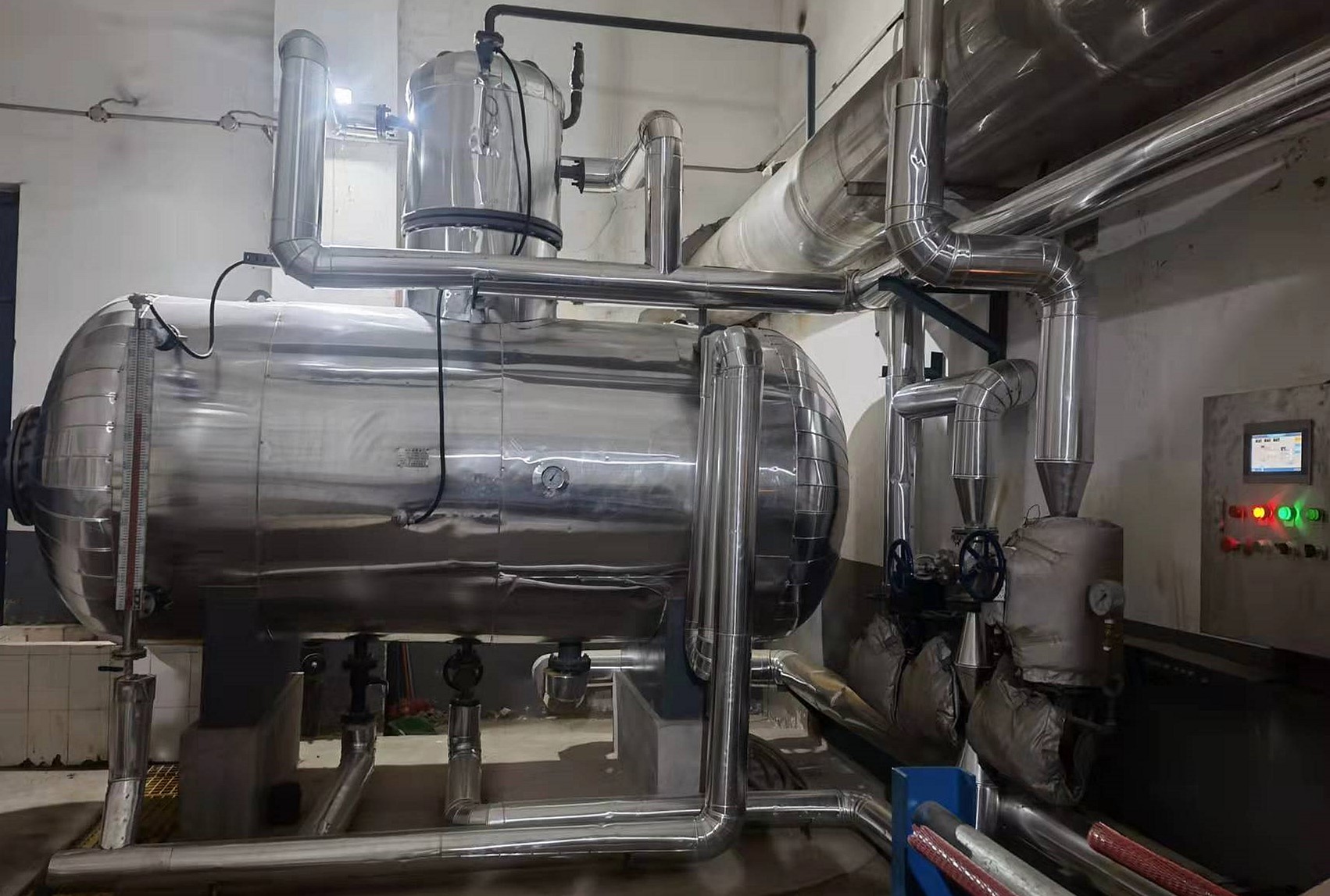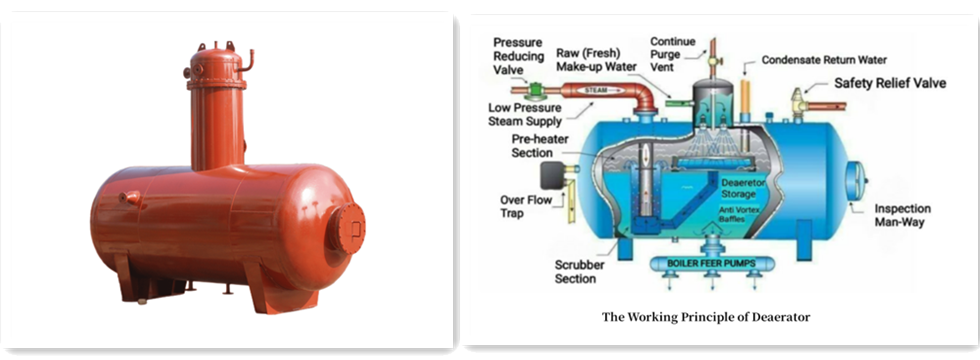Overview
Industrial grade boilers are a major investment, making it extremely important to extend their lives and maintain their efficiency for as long as possible. Corrosion is a major factor in the failure of boilers, which is where the deaeration process comes in. Deaeration involves oxygen removal, as well as carbon dioxide removal, thus extending the life and efficiency of a boiler system – it is very pertinent that the makeup water entering a boiler is free of these dissolved gases. The major area of application for deaerators can be found within a boiler plant and boiler feed water systems.
We understand the investment you’ve made in your boiler system, and we’re prepared to help you keep it in great working order by installing a deaerator with PLC control system that will remove the dissolved gasses that cause corrosion and threaten the ability of the boiler to do its job.
What is the Purpose of a Deaerator?
The deaerator’s job is to remove oxygen and other dissolved gases from boiler feedwater, creating clean, deaerated water.The deaerator achieves this task by reducing the level of dissolved oxygen and carbon dioxide in the feedwater, which in turn reduces the amount of corrosive compounds within the steam system over time. When the deaerated water exits the deaerator, carbon dioxide concentrations will be zero and dissolved oxygen concentrations will be less than or equal to 7 ppb (parts per billion) (this can be tested through an extraction point). Deaerators also reduce the need for water treatment chemicals, such as an oxygen scavenger,
In addition to reducing dissolved gasses in the feedwater to reduce corrosion damage, a deaerator also raises the temperature of the feedwater before it enters the boiler, thus requiring less fuel for the boiler to heat the water hot enough to produce steam. As a result, the boiler system performs better, is more efficient overall, and helps maintain operating costs.
Why Remove Dissolved Gases from Feedwater?
The deaeration process is used to reduce corrosion and to remove dissolved gases in specific boiler feed water systems. The presence of dissolved gasses like oxygen and carbon dioxide causes accelerated corrosion that shortens the lifespan and reduces the efficiency of a boiler system. One of the more serious corrosion issues with dissolved oxygen is pitting. Although the metal loss with pitting is minimal and the corrosion level relatively low, pitting causes system failure just the same.
The degree to which the oxygen attacks the system depends on the amount of dissolved oxygen, the feedwater temperature, and the pH level of the water. Hot water does not cause corrosion by itself, but even the smallest amount of oxygen present in elevated water temperatures causes serious problems because the rise in temperature is just the accelerant the gas needs to cause corrosion.
Another destructive dissolved gas found in boiler feedwater is carbon dioxide. This gas creates a weak carbonic acid that attacks the metal inside boilers, feed systems, and condensate return/condensate systems.
Because these gasses have such a corrosive effect on these systems, they must be removed from all sources of water entering the system, which is where the deaeration process comes in.
The Function of a Deaerator
Principle of Deaerator
The Working Principle of Deaerator
Deaerators operate on Henry’s Law of Partial Pressure, a principle in physical chemistry that says that the quantity of dissolved gas in a liquid is directly proportional to the partial pressure above that liquid. When deaeration takes place, the partial pressure above the boiler feedwater is decreased as the water’s temperature rises. Simply stated, the solubility of the gases in the water is decreased as the temperature of the water increases.
The solubility of oxygen in water decreases as the water temperature increases. However, as the water temperature increases and approaches saturation temperature, so does the amount of water vapor in the atmosphere above the liquid. When the water reaches full saturation temperature (boiling point), theoretically there is zero oxygen left in the water. In conclusion, due to these physical characteristics, oxygen can be removed from water by raising the temperature and reducing the concentration of dissolved oxygen in the atmosphere above the water.
The Goals of a Deaerator
Measuring the technical efficiency of a deaerator depends on its operational effectiveness in the amount of oxygen content it removes from the boiler’s feed water. In addition, measurements are taken for the amount of gas that shows up at the inlet of the storage tank and what the amount is at the feedwater’s outlet.
PLC Control System
The PLC deaerator control system has automatic control functions such as deaerator liquid level control, deaerator temperature control, water shortage alarm, over-temperature alarm, etc., realizing intelligent control. This control system has good reliability and high degree of automation , Easy to use, simple operation, rich functions, flexible control, beautiful appearance, high cost performance and so on.
The control panel used in this control system is independently developed by us. This control panel is developed by our R&D team according to the customer's process flow and parameter requirements to suit the customer's system control panel.The control panel is more concise and intuitive, with a humanized man-machine interface, which is easy to operate and use. Equipped with a touch screen, the system will have a good human-machine interface, which can display the complete system operating status, equipment status and various parameters, and the operating parameters are centralized digital display. It can be controlled locally, and can also be networked with the central control room to facilitate remote monitoring by users.

Technical Parameter
|
Name |
Thermal Deaerator/Steam Deaerator/Thermal Spraying Oxygen Eliminator/Oxygen Extrator/Deaerator Equipment |
|
Application Field |
Industrial Boiler /Power Plant/Power Station Boiler |
|
Materials |
Carbon Steel,Stainless Steel.etc |
|
Capacity |
2-250T Boiler |
|
Working Temperature |
98-105℃/130-135℃/160-165℃ |
|
Design Temperature |
230℃ |
|
Design Pressure |
0.04MPa |
|
Working Pressure |
0.02MPa |
|
Control Mould |
PLC(SIEMENS SIMATIC S7-200 SMART) |
|
Water Tank Diameter |
φ900∽φ3250 or customized |
|
Water Tank Length |
According to customer requirements |
|
Welding |
Automatic GMAW,GTAW(TIG) |
|
Welding NDT |
100%RT,100%PT |
|
Note: Parameter is for reference only, if any changes should follow the factory technical data. |
Common Questions About Deaerators
Why are deaerators placed at height?
Deaerator is placed at height to provide sufficient NPSHa (Net Positive Suction Head available) to the boiler feedwater pumps – the boiler feed pumps are typically situated low in the ship for the same reason. Also, to allow air in the system to rise and enter the deaerator which, because of its name, will then discharge the air to either the atmosphere or the condenser. It’s important to deaerate the feed water at the point just prior to the feed pumps in order to avoid it passing to the boilers, where it will accelerate corrosion.
Is a deaerator a pressure vessel?
Not all deaerators are pressure vessels. Some deaerators called atmospheric deaerators have a temperature regulator rather than a pressure regulator to regulate steam. Temperature regulators are not as responsive as pressure regulators, which is why pressurized deaerators are more commonly used and come in a wide range of pressure ratings.
If you want to know more information, please contact us, we will work out an optimization plan according to your needs for your reference.




